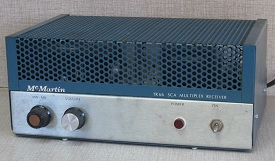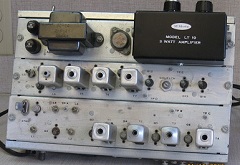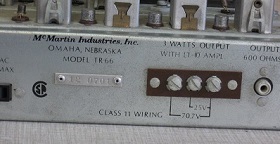Vintage Audio: McMartin TR-66 FM-SCA Receiver | Telos Alliance
By The Telos Alliance Team on Mar 4, 2015 2:57:00 PM
 Vintage Tech: McMartin TR-66 FM-SCA Receiver
Vintage Tech: McMartin TR-66 FM-SCA Receiver
Broadcasting, by its very definition, means using an RF signal to reach as large an audience as possible. So the opposite of broadcasting is narrowcasting, targeting a small, niche of the population. In the Internet age, with web streams and podcasts, it’s easy to reach out to a handful of people scattered across the globe. Just twenty short years ago, narrowcasting to a small audience was a much more involved affair. This month's Found in the Attic examines a 1960s-vintage McMartin TR-66 FM-SCA receiver, and the related technology of FM subcarriers.
The use of subcarriers by FM broadcasters was defined by the FCC under the term SCA – Subsidiary Communications Authorization. The Commission's rules were not too specific, but described an audio or data channel that is transmitted along with the main audio signal over a broadcast station. These subcarrier channels (typically 67 and 92 KHz) are not receivable with a regular radio; special receivers, such as the TR-66 are required.
The technology was developed during WW II, largely by the US Navy. One of the early pioneers and developers was Leonard E. Hedlund, who worked as the principle design engineer for many of the early McMartin FM and SCA products.
FM SCAs could be utilized by any small population within the station's coverage area. Muzak was undoubtedly the largest user. The term 'elevator music' was often used to describe Muzak's programming, although it was most often heard in stores and professional office environments.
Muzak's programming usually arrived at the FM station's transmitter site via equalized phone lines. Audio processing was sometimes applied, and then the signal went into a subcarrier generator, which was connected to the exciter.
On the receiving end, a rooftop antenna was essential. Subcarrier signals were even more sensitive to multipath issues than stereo. A high-gain, cut-to-frequency directional antenna was usually deployed, typically a 3- or 5-element, single bay, Yagi configuration, even in areas with strong signal. Often, the best signal did not arrive in the horizontal plane, and rotation adapters were often used on the antenna to tilt the antenna for the best signal. Installers often used a field strength meter to adjust the antenna for the combination of best signal and lowest multipath.
An SCA receiver, such as the TR-66, was connected to a short run of coax from the antenna, and usually to an audio amplifier feeding a 70-volt distribution system, which connected the signal to a series of ceiling-mounted speakers.
Typical of 1960s equipment, the TR-66 featured battleship-quality construction, and, like most McMartin SCA gear, had a reputation for reliable operation and long life. The chassis featured modular, straight-line design with numerous test points and transistor sockets, making them easy to align and service. The units were hand-wired, and the quality of craftsmanship was excellent. An optional LT-10 3-watt audio amplifier could be plugged into an octal connector on top of the chassis, making the TR-66 a tuner-amplifier in one chassis.
The TR-66 was crystal controlled, and extremely stable. If the frequency was changed or alignment needed to be checked, it was simply a matter of connecting a VTVM to the correct test points, peaking up the local oscillator until the voltage dropped to 2/10 of a volt above peak to ensure positive starting. Next connect to the AGC test point and tune the antenna coil, RF coil mixer coil and doubler coil for minimum positive voltage at the AGC test point. Then, set the RF mute level control to cut off around 5 microvolts of RF input level, and then adjust the subchannel mute.
The use of FM SCAs for distribution of background music and niche programming began to decline in the mid-1980s. At that time, satellite distribution to the end user became an affordable alternative. Gradually, the 5-element SCA antennas visible on rooftops at the mall began to disappear as small satellite dishes took their place. Storecasting via satellite evolved into a specialized service in its own right.
Reading services for the blind continued to use the service, with handheld and desktop receivers. They were also used by ethnic populations in large cities for foreign language broadcasts. For them, the advantages were the low cost of desktop receivers, and the simplicity, for populations that were largely computer illiterate.
FM SCA equipment is a fast-fading footnote in the history of broadcast technology, but the FM subcarrier lives on with RDS, the 57 KHz digital subcarrier used to distribute the artist, song title, and other text data displayed on the digital dashboard of today's car radios.
McMartin Industries is best remembered for its line of FM monitors, broadcast transmitters and audio gear, but the company was also heavily involved in the FM subcarrier and background music business. Its product line included FM-SCA receivers, SCA field strength meters, antennas and related gear. Major customers included Muzak, the Physician's Radio Network, and many radio reading services for the blind.
Under the Engineered Sound brand, McMartin also sold thousands of audio amplifiers, and did custom sound projects for BART San Francisco, MARTA Atlanta, and WMATA Washington, DC, as well as off-the-shelf sound and paging installations at countless churches, schools, and other public buildings.
McMartin was founded in 1956 by Ray McMartin, under the name Continental Manufacturing, Inc. In the early days, it manufactured and sold consumer electronic devices. It began selling broadcast gear as McMartin Industries Inc. in 1962. The company began with modest monthly sales of $600,000 in 1963, growing to $1 million in 1973, and peaking at over $10 million in 1979.
Rising interest rates, declining sales of SCA gear and a general economic downturn led to McMartin Industries being foreclosed by bankers in the early 1980s. Two later attempts to revive the company also failed, and McMartin Industries closed its doors for good in 1985. Today, manuals, parts and repair service for many McMartin products are available from Goodrich Enterprises of Omaha, NE.
 Our TR-66 was rescued from a downtown building that was about to be demolished in the early 1980s. It was found in a utility closet, still connected to an antenna and ceiling-mounted speakers in the storefront, although it is doubtful it had worked since the 1960s. It was put back in working order and used to monitor the local radio reading service through the late 1980s, when it went into the attic.
Our TR-66 was rescued from a downtown building that was about to be demolished in the early 1980s. It was found in a utility closet, still connected to an antenna and ceiling-mounted speakers in the storefront, although it is doubtful it had worked since the 1960s. It was put back in working order and used to monitor the local radio reading service through the late 1980s, when it went into the attic.
Today, after 30 years of slumber, it still receives a crisp, clean signal from the local PBS station, although the SCA signal with the radio reading service is long gone.
Telos Alliance has led the audio industry’s innovation in Broadcast Audio, Digital Mixing & Mastering, Audio Processors & Compression, Broadcast Mixing Consoles, Audio Interfaces, AoIP & VoIP for over three decades. The Telos Alliance family of products include Telos® Systems, Omnia® Audio, Axia® Audio, Linear Acoustic®, 25-Seven® Systems, Minnetonka™ Audio and Jünger Audio. Covering all ranges of Audio Applications for Radio & Television from Telos Infinity IP Intercom Systems, Jünger Audio AIXpressor Audio Processor, Omnia 11 Radio Processors, Axia Networked Quasar Broadcast Mixing Consoles and Linear Acoustic AMS Audio Quality Loudness Monitoring and 25-Seven TVC-15 Watermark Analyzer & Monitor. Telos Alliance offers audio solutions for any and every Radio, Television, Live Events, Podcast & Live Streaming Studio With Telos Alliance “Broadcast Without Limits.”
Recent Posts
Subscribe
If you love broadcast audio, you'll love Telos Alliance's newsletter. Get it delivered to your inbox by subscribing below!